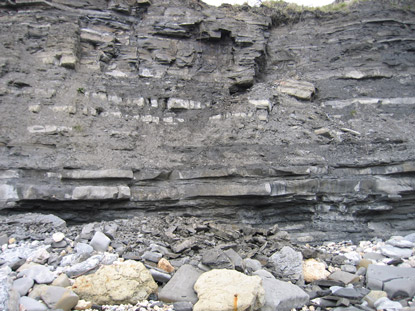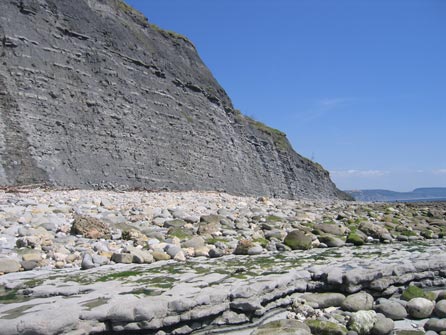Latest Update on Lyme Regis Landslide
Latest news on Lyme Regis Landslide
Late on the evening of 6th May this year, there was a major landslide at the cliffs between Lyme Regis and the village of Charmouth, on the Dorset coast. A section of cliff, approximately 400 metres long slipped and this led to the biggest landslide in the area for nearly 100 years. Everything Dinosaur team members had been at that very spot just 24-hours before scouring the beach looking for fossils, they had commented on the excess water within some sections of the cliff and there was evidence of recent rock falls both on the Black Ven side of Lyme Regis and further to the west on Monmouth beach.
Despite the dangerous nature of the cliffs, we observed a number of tourists (after all it was the Bank Holiday weekend), venturing very close to the base of the cliffs, even one fool hardy group started to climb up a section a few hundred yards to the west of the Charmouth visitor centre.
The Dangerous Cliffs at Lyme Regis

Picture credit: Everything Dinosaur
The picture above was taken at Monmouth beach in early May, evidence of a recent rock fall can clearly be seen. The cliffs are extremely dangerous and they are best avoided, as the beach itself can provide plenty of opportunities to find fossils. The soft mud and clay gets washed out of the cliffs and deposits fossils on the shoreline, so there is a constant supply of new fossils to find. This is a much safer option, especially when you consider that after the landslide on the 6th May there were boulders the size of cars tumbling down onto the base of the cliffs.
Everything Dinosaur stocks a range of models representing iconic animals from the fossil record such as ammonites and belemnites: Replica Fossils and Models.
Lyme Regis Landslide
According to Brandon Lennon, a professional fossil collector, the landslip has cut Black Ven in half, from a fossil collector’s perspective the landslide affected the wrong section of cliff, if the Church Cliffs section closer to Lyme Regis had collapsed then many more vertebrate and invertebrate fossils would have been exposed. It is highly likely that more ichthyosaur and plesiosaur remains would have been discovered with maybe one or two pterosaur fossils.
Unfortunately, the landslip laid bare the old town rubbish dump, and a lot of rubbish and debris has ended up on the beach. The cliffs remain unstable and for a few days after the main landslide a number of smaller slips occurred, one of which was filmed by Brandon.

Good idea to go fossil collecting on a falling tide and to keep away from the steep cliffs. Landslides are common and very dangerous.
Picture credit: Everything Dinosaur
To read more about the dangerous cliffs on the Dorset coast: Jurassic June Fossil Hunting Code.
Our thanks to Brandon for permission to link to this clip.
Collecting Fossils
Immediately, following the main landslide many local fossil collectors gathered in expectation of finding spectacular new Jurassic fossils, unfortunately, so far the results have been disappointing.
Brandon comments: “The odd vertebra has been found on a very low tide and this is the only safe time you can go out to the Black Ven. There is a lot of broken glass all over the place and even big lumps of metal work, if the fall had occurred a few hundred feet nearer to Lyme Regis we would be finding just great stuff everywhere”!
Perhaps the safest way to explore the beaches at Lyme Regis is to go out with a professional fossil collector who will be able to guide you across the beaches and show you the best places to find fossils. Local knowledge can be extremely useful and indeed if you want to get the most out of a trip to this part of the Dorset coast, a guided fossil work is a must.
Guided Fossil Walks
For instance, Brandon and his team have modified their guided fossil collecting trips in the light of the recent landslide. At the moment he is leading trips to Monmouth beach to the west of Lyme Regis, taking in a visit to the world famous ammonite graveyard and to see the sunstone a little further beyond the Blue Lias Limestones at Seven Rocks Point towards Pinhay Bay. This area has also suffered from rock falls recently. The rough weather has led to the cliffs in this area becoming saturated and the landslip at Seven Rocks Point has moved forward a bit. Under the guidance of a professional such as Brandon, tour parties are escorted to areas where scouting for fossils can be safely carried out. Visitors also have the opportunity to view items that they themselves would not necessarily spot, for example, just beyond Seven Rocks Point the recent erosion has exposed a big Arietites sp. ammonite. It is sticking out of the cliffs by a waterfall and will fall onto the beach in the near future. Large Arietites are relatively rare although this genus of ammonite is very important to geologists as a number of species act as zonal fossils and assist with the process of biostratigraphy (fossils used to date the relative age of rock strata).
To book a guided fossil walk with Brandon, walks take place daily from Saturday to Tuesday, for most of the year: Lyme Regis Fossil Walks with Brandon Lennon.

